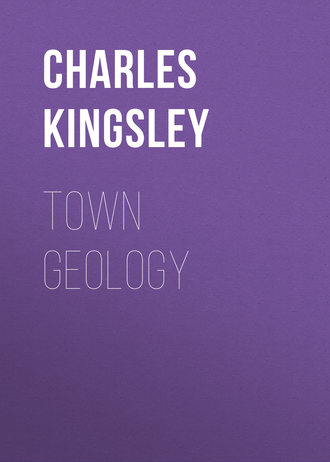 полная версия
полная версияTown Geology
But some one may say, and will have a right to say, “Stop—the lower thing may have been thrust under the upper one.” Quite true: and therefore I said only that the lower one was most probably put there first. And I said “most probably,” because it is most probable that in nature we should find things done by the method which costs least force, just as you do them. I will warrant that when you want to hide a thing, you lay something down on it ten times for once that you thrust it under something else. You may say, “What? When I want to hide a paper, say, under the sofa-cover, do I not thrust it under?”
No, you lift up the cover, and slip the paper in, and let the cover fall on it again. And so, even in that case, the paper has got into its place first.
Now why is this? Simply because in laying one thing on another you only move weight. In thrusting one thing under another, you have not only to move weight, but to overcome friction. That is why you do it, though you are hardly aware of it: simply because so you employ less force, and take less trouble.
And so do clays and sands and stones. They are laid down on each other, and not thrust under each other, because thus less force is expended in getting them into place.
There are exceptions. There are cases in which nature does try to thrust one rock under another. But to do that she requires a force so enormous, compared with what is employed in laying one rock on another, that (so to speak) she continually fails; and instead of producing a volcanic eruption, produces only an earthquake. Of that I may speak hereafter, and may tell you, in good time, how to distinguish rocks which have been thrust in from beneath, from rocks which have been laid down from above, as every rock between London and Birmingham or Exeter has been laid down. That I only assert now. But I do not wish you to take it on trust from me. I wish to prove it to you as I go on, or to do what is far better for you: to put you in the way of proving it for yourself, by using your common sense.
At the risk of seeming prolix, I must say a few more words on this matter. I have special reasons for it. Until I can get you to “let your thoughts play freely” round this question of the superposition of soils and rocks, there will be no use in my going on with these papers.
Suppose then (to argue from the known to the unknown) that you were watching men cleaning out a pond. Atop, perhaps, they would come to a layer of soft mud, and under that to a layer of sand. Would not common sense tell you that the sand was there first, and that the water had laid down the mud on the top of it? Then, perhaps, they might come to a layer of dead leaves. Would not common sense tell you that the leaves were there before the sand above them? Then, perhaps, to a layer of mud again. Would not common sense tell you that the mud was there before the leaves? And so on down to the bottom of the pond, where, lastly, I think common sense would tell you that the bottom of the pond was there already, before all the layers which were laid down on it. Is not that simple common sense?
Then apply that reasoning to the soils and rocks in any spot on earth. If you made a deep boring, and found, as you would in many parts of this kingdom, that the boring, after passing through the soil of the field, entered clays or loose sands, you would say the clays were there before the soil. If it then went down into sandstone, you would say—would you not?—that sandstone must have been here before the clay; and however thick—even thousands of feet—it might be, that would make no difference to your judgment. If next the boring came into quite different rocks; into a different sort of sandstone and shales, and among them beds of coal, would you not say—These coal-beds must have been here before the sandstones? And if you found in those coal-beds dead leaves and stems of plants, would you not say—Those plants must have been laid down here before the layers above them, just as the dead leaves in the pond were?
If you then came to a layer of limestone, would you not say the same? And if you found that limestone full of shells and corals, dead, but many of them quite perfect, some of the corals plainly in the very place in which they grew, would you not say—These creatures must have lived down here before the coal was laid on top of them? And if, lastly, below the limestone you came to a bottom rock quite different again, would you not say—The bottom rock must have been here before the rocks on the top of it?
And if that bottom rock rose up a few miles off, two thousand feet, or any other height, into hills, what would you say then? Would you say: “Oh, but the rock is not bottom rock; is not under the limestone here, but higher than it. So perhaps in this part it has made a shift, and the highlands are younger than the lowlands; for see, they rise so much higher?” Would not that be as wise as to say that the bottom of the pond was not there before the pond mud, because the banks round the pond rose higher than the mud?
Now for the soil of the field.
If we can understand a little about it, what it is made of, and how it got there, we shall perhaps be on the right road toward understanding what all England—and, indeed, the crust of this whole planet—is made of; and how its rocks and soils got there.
But we shall best understand how the soil in the field was made, by reasoning, as I have said, from the known to the unknown. What do I mean? This: On the uplands are fields in which the soil is already made. You do not know how? Then look for a field in which the soil is still being made. There are plenty in every lowland. Learn how it is being made there; apply the knowledge which you learn from them to the upland fields which are already made.
If there is, as there usually is, a river-meadow, or still better, an æstuary, near your town, you have every advantage for seeing soil made. Thousands of square feet of fresh-made soil spread between your town and the sea; thousands more are in process of being made.
You will see now why I have begun with the soil in the field; because it is the uppermost, and therefore latest, of all the layers; and also for this reason, that, if Sir Charles Lyell’s theory be true—as it is—then the soils and rocks below the soil of the field may have been made in the very same way in which the soil of the field is made. If so, it is well worth our while to examine it.
You all know from whence the soil comes which has filled up, in the course of ages, the great æstuaries below London, Stirling, Chester, or Cambridge.
It is river mud and sand. The river, helped by tributary brooks right and left, has brought down from the inland that enormous mass. You know that. You know that every flood and freshet brings a fresh load, either of fine mud or of fine sand, or possibly some of it peaty matter out of distant hills. Here is one indisputable fact from which to start. Let us look for another.
How does the mud get into the river? The rain carries it thither.
If you wish to learn the first elements of geology by direct experiment, do this: The next rainy day—the harder it rains the better—instead of sitting at home over the fire, and reading a book about geology, put on a macintosh and thick boots, and get away, I care not whither, provided you can find there running water. If you have not time to get away to a hilly country, then go to the nearest bit of turnpike road, or the nearest sloping field, and see in little how whole continents are made, and unmade again. Watch the rain raking and sifting with its million delicate fingers, separating the finer particles from the coarser, dropping the latter as soon as it can, and carrying the former downward with it toward the sea. Follow the nearest roadside drain where it runs into a pond, and see how it drops the pebbles the moment it enters the pond, and then the sand in a fan-shaped heap at the nearest end; but carries the fine mud on, and holds it suspended, to be gradually deposited at the bottom in the still water; and say to yourself: Perhaps the sands which cover so many inland tracts were dropped by water, very near the shore of a lake or sea, and by rapid currents. Perhaps, again, the brick clays, which are often mingled with these sands, were dropped, like the mud in the pond, in deeper water farther from the shore, and certainly in stilt water. But more. Suppose once more, then, that looking and watching a pond being cleared out, under the lowest layer of mud, you found—as you would find in any of those magnificent reservoirs so common in the Lancashire hills—a layer of vegetable soil, with grass and brushwood rooted in it. What would you say but: The pond has not been always full. It has at some time or other been dry enough to let a whole copse grow up inside it?
And if you found—as you will actually find along some English shores—under the sand hills, perhaps a bed of earth with shells and bones; under that a bed of peat; under that one of blue silt; under that a buried forest, with the trees upright and rooted; under that another layer of blue silt full of roots and vegetable fibre; perhaps under that again another old land surface with trees again growing in it; and under all the main bottom clay of the district—what would common sense tell you? I leave you to discover for yourselves. It certainly would not tell you that those trees were thrust in there by a violent convulsion, or that all those layers were deposited there in a few days, or even a few years; and you might safely indulge in speculations about the antiquity of the æstuary, and the changes which it has undergone, with which I will not frighten you at present.
It will be fair reasoning to argue thus. You may not be always right in your conclusion, but still you will be trying fairly to explain the unknown by the known.
But have Rain and Rivers alone made the soil?
How very much they have done toward making it you will be able to judge for yourselves, if you will read the sixth chapter of Sir Charles Lyell’s new “Elements of Geology,” or the first hundred pages of that admirable book, De la Bêche’s “Geological Observer;” and last, but not least, a very clever little book called “Rain and Rivers,” by Colonel George Greenwood.
But though rain, like rivers, is a carrier of soil, it is more. It is a maker of soil, likewise; and by it mainly the soil of an upland field is made, whether it be carried down to the sea or not.
If you will look into any quarry you will see that however compact the rock may be a few feet below the surface, it becomes, in almost every case, rotten and broken up as it nears the upper soil, till you often cannot tell where the rock ends and the soil begins.
Now this change has been produced by rain. First, mechanically, by rain in the shape of ice. The winter rain gets into the ground, and does by the rock what it has done by the stones of many an old building. It sinks into the porous stone, freezes there, expands in freezing, and splits and peels the stone with a force which is slowly but surely crumbling the whole of Northern Europe and America to powder.
Do you doubt me? I say nothing but what you can judge of yourselves. The next time you go up any mountain, look at the loose broken stones with which the top is coated, just underneath the turf. What has broken them up but frost? Look again, as stronger proof, at the talus of broken stones—screes, as they call them in Scotland; rattles, as we call them in Devon—which lie along the base of many mountain cliffs. What has brought them down but frost? If you ask the country folk they will tell you whether I am right or not. If you go thither, not in the summer, but just after the winter’s frost, you will see for yourselves, by the fresh frost-crop of newly-broken bits, that I am right. Possibly you may find me to be even more right than is desirable, by having a few angular stones, from the size of your head to that of your body, hurled at you by the frost-giants up above. If you go to the Alps at certain seasons, and hear the thunder of the falling rocks, and see their long lines—moraines, as they are called—sliding slowly down upon the surface of the glacier, then you will be ready to believe the geologist who tells you that frost, and probably frost alone, has hewn out such a peak as the Matterhorn from some vast table-land; and is hewing it down still, winter after winter, till some day, where the snow Alps now stand, there shall be rolling uplands of rich cultivable soil.
So much for the mechanical action of rain, in the shape of ice. Now a few words on its chemical action.
Rain water is seldom pure. It carries in it carbonic acid; and that acid, beating in shower after shower against the face of a cliff—especially if it be a limestone cliff—weathers the rock chemically; changing (in case of limestone) the insoluble carbonate of lime into a soluble bicarbonate, and carrying that away in water, which, however clear, is still hard. Hard water is usually water which has invisible lime in it; there are from ten to fifteen grains and more of lime in every gallon of limestone water. I leave you to calculate the enormous weight of lime which must be so carried down to the sea every year by a single limestone or chalk brook. You can calculate it, if you like, by ascertaining the weight of lime in each gallon, and the average quantity of water which comes down the stream in a day; and when your sum is done, you will be astonished to find it one not of many pounds, but probably of many tons, of solid lime, which you never suspected or missed from the hills around. Again, by the time the rain has sunk through the soil, it is still less pure. It carries with it not only carbonic acid, but acids produced by decaying vegetables—by the roots of the grasses and trees which grow above; and they dissolve the cement of the rock by chemical action, especially if the cement be lime or iron. You may see this for yourselves, again and again. You may see how the root of a tree, penetrating the earth, discolours the soil with which it is in contact. You may see how the whole rock, just below the soil, has often changed in colour from the compact rock below, if the soil be covered with a dense layer of peat or growing vegetables.
But there is another force at work, and quite as powerful as rain and rivers, making the soil of alluvial flats. Perhaps it has helped, likewise, to make the soil of all the lowlands in these isles—and that is, the waves of the sea.
If you ever go to Parkgate, in Cheshire, try if you cannot learn there a little geology.
Walk beyond the town. You find the shore protected for a long way by a sea-wall, lest it should be eaten away by the waves. What the force of those waves can be, even on that sheltered coast, you may judge—at least you could have judged this time last year—by the masses of masonry torn from their iron clampings during the gale of three winters since. Look steadily at those rolled blocks, those twisted stanchions, if they are there still; and then ask yourselves—it will be fair reasoning from the known to the unknown—What effect must such wave-power as that have had beating and breaking for thousands of years along the western coasts of England, Scotland, Ireland? It must have eaten up thousands of acres—whole shires, may be, ere now. Its teeth are strong enough, and it knows neither rest nor pity, the cruel hungry sea. Give it but time enough, and what would it not eat up? It would eat up, in the course of ages, all the dry land of this planet, were it not baffled by another counteracting force, of which I shall speak hereafter.
As you go on beyond the sea-wall, you find what it is eating up. The whole low cliff is going visibly. But whither is it going? To form new soil in the æstuary. Now you will not wonder how old harbours so often become silted up. The sea has washed the land into them. But more, the sea-currents do not allow the sands of the æstuary to escape freely out to sea. They pile it up in shifting sand-banks about the mouth of the æstuary. The prevailing sea-winds, from whatever quarter, catch up the sand, and roll it up into sand-hills. Those sand-hills are again eaten down by the sea, and mixed with the mud of the tide-flats, and so is formed a mingled soil, partly of clayey mud, partly of sand; such a soil as stretches over the greater part of all our lowlands.
Now, why should not that soil, whether in England or in Scotland, have been made by the same means as that of every æstuary.
You find over great tracts of East Scotland, Lancashire, Norfolk, etc., pure loose sand just beneath the surface, which looks as if it was blown sand from a beach. Is it not reasonable to suppose that it is? You find rising out of many lowlands, crags which look exactly like old sea-cliffs eaten by the waves, from the base of which the waters have gone back. Why should not those crags be old sea-cliffs? Why should we not, following our rule of explaining the unknown by the known, assume that such they are till someone gives us a sound proof that they are not; and say—These great plains of England and Scotland were probably once covered by a shallow sea, and their soils made as the soil of any tide-flat is being made now?
But you may say, and most reasonably “The tide-flats are just at the sea-level. The whole of the lowland is many feet above the sea; it must therefore have been raised out of the sea, according to your theory: and what proofs have you of that?”
Well, that is a question both grand and deep, on which I shall not enter yet; but meanwhile, to satisfy you that I wish to play fair with you, I ask you to believe nothing but what you can prove for yourselves. Let me ask you this: suppose that you had proof positive that I had fallen into the river in the morning; would not your meeting me in the evening be also proof positive that somehow or other I had in the course of the day got out of the river? I think you will accept that logic as sound.
Now if I can give you proof positive, proof which you can see with your own eyes, and handle with your own hands, and alas! often feel but too keenly with your own feet, that the whole of the lowlands were once beneath the sea; then will it not be certain that, somehow or other, they must have been raised out of the sea again?
And that I propose to do in my next paper, when I speak of the pebbles in the street.
Meanwhile I wish you to face fairly the truly grand idea, which all I have said tends to prove true—that all the soil we see is made by the destruction of older soils, whether soft as clay, or hard as rock; that rain, rivers, and seas are perpetually melting and grinding up old land, to compose new land out of it; and that it must have been doing so, as long as rain, rivers, and seas have existed. “But how did the first land of all get made?” I can only reply: A natural question: but we can only answer that, by working from the known to the unknown. While we are finding out how these later lands were made and unmade, we may stumble on some hints as to how the first primeval continents rose out of the bosom of the sea.
And thus I end this paper. I trust it has not been intolerably dull. But I wanted at starting to show my readers something of the right way of finding out truth on this and perhaps on all subjects; to make some simple appeals to your common sense; and to get you to accept some plain rules founded on common sense, which will be of infinite use to both you and me in my future papers.
I hope, meanwhile, that you will agree with me, that there is plenty of geological matter to be seen and thought over in the neighbourhood of any town.
Be sure, that wherever there is a river, even a drain; and a stone quarry, or even a roadside bank; much more where there is a sea, or a tidal æstuary, there is geology enough to be learnt, to explain the greater part of the making of all the continents on the globe.
II. THE PEBBLES IN THE STREET
If you, dear reader, dwell in any northern town, you will almost certainly see paving courts and alleys, and sometimes—to the discomfort of your feet—whole streets, or set up as bournestones at corners, or laid in heaps to be broken up for road-metal, certain round pebbles, usually dark brown or speckled gray, and exceedingly tough and hard. Some of them will be very large—boulders of several feet in diameter. If you move from town to town, from the north of Scotland as far down as Essex on the east, or as far down as Shrewsbury and Wolverhampton (at least) on the west, you will still find these pebbles, but fewer and smaller as you go south. It matters not what the rocks and soils of the country round may be. However much they may differ, these pebbles will be, on the whole, the same everywhere.
But if your town be south of the valley of the Thames, you will find, as far as I am aware, no such pebbles there. The gravels round you will be made up entirely of rolled chalk flints, and bits of beds immediately above or below the chalk. The blocks of “Sarsden” sandstone—those of which Stonehenge is built—and the “plum-pudding stones” which are sometimes found with them, have no kindred with the northern pebbles. They belong to beds above the chalk.
Now if, seeing such pebbles about your town, you inquire, like a sensible person who wishes to understand something of the spot on which he lives, whence they come, you will be shown either a gravel-pit or a clay-pit. In the gravel the pebbles and boulders lie mixed with sand, as they do in the railway cutting just south of Shrewsbury; or in huge mounds of fine sweet earth, as they do in the gorge of the Tay about Dunkeld, and all the way up Strathmore, where they form long grassy mounds—tomauns as they call them in some parts of Scotland—askers as they call them in Ireland. These mounds, with their sweet fresh turf rising out of heather and bog, were tenanted—so Scottish children used to believe—by fairies. He that was lucky might hear inside them fairy music, and, the jingling of the fairy horses’ trappings. But woe to him if he fell asleep upon the mound, for he would be spirited away into fairyland for seven years, which would seem to him but one day. A strange fancy; yet not so strange as the actual truth as to what these mounds are, and how they came into their places.
Or again, you might find that your town’s pebbles and boulders came out of a pit of clay, in which they were stuck, without any order or bedding, like plums and raisins in a pudding. This clay goes usually by the name of boulder-clay. You would see such near any town in Cheshire and Lancashire; or along Leith shore, near Edinburgh; or, to give one more instance out of hundreds, along the coast at Scarborough. If you walk along the shore southward of that town, you will see, in the gullies of the cliff, great beds of sticky clay, stuffed full of bits of every rock between the Lake mountains and Scarborough, from rounded pebbles of most ancient rock down to great angular fragments of ironstone and coal. There, as elsewhere, the great majority of the pebbles have nothing to do with the rock on which the clay happens to lie, but have come, some of them, from places many miles away.
Now if we find spread over a low land pebbles composed of rocks which are only found in certain high lands, is it not an act of common sense to say—These pebbles have come from the highlands? And if the pebbles are rounded, while the rocks like them in the highlands always break off in angular shapes, is it not, again, an act of mere common sense to say—These pebbles were once angular, and have been rubbed round, either in getting hither or before they started hither?
Does all this seem to you mere truism, my dear reader? If so, I am sincerely glad to hear it. It was not so very long ago that such arguments would have been considered not only no truisms, but not even common sense.
But to return, let us take, as an example, a sample of these boulder clay pebbles from the neighbourhood of Liverpool and Birkenhead, made by Mr. De Rance, the government geological surveyor:
Granite, greenstone, felspar porphyry, felstone, quartz rock (all igneous rocks, that is, either formed by, or altered by volcanic heat, and almost all found in the Lake mountains), 37 per cent.
Silurian grits (the common stones of the Lake mountains deposited by water), 43 per cent.
Ironstone, 1 per cent.
Carboniferous limestone, 5 per cent.











